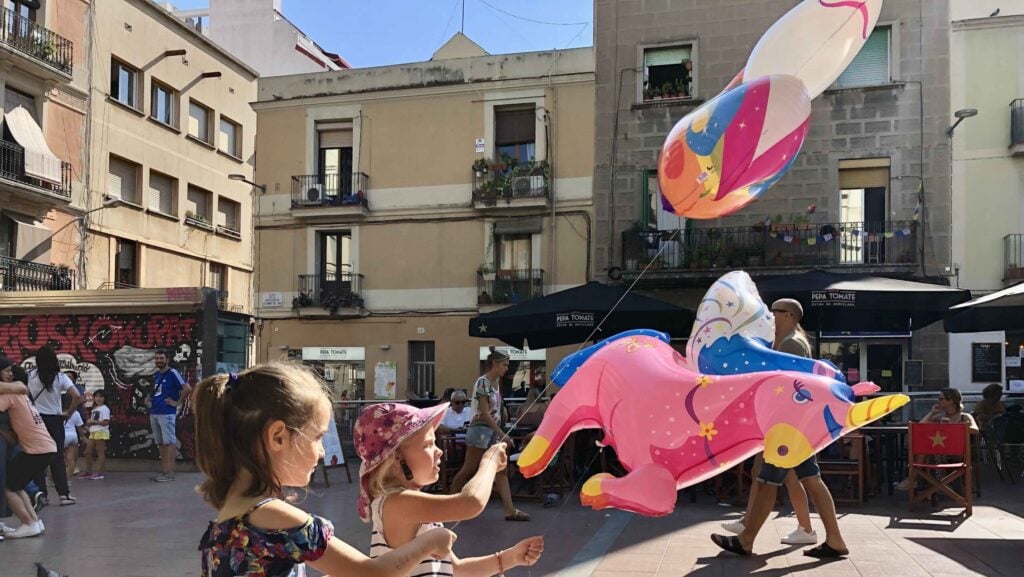- I’ve been using family travel as a way to teach my kids about money since they were little.
- It’s an engaging and real-life way to teach kids about budgeting, financial decision making, and more advanced topics like exchange rates (chances to do math with them on the fly).
- It’s also a way to start teaching them to be great future travelers, one small step at a time.
When I first started traveling with kids, I didn’t realize just how much money lessons and travel could go hand in hand. But over the years, I’ve realized how travel is actually an easy way to teach kids about money that will boost their financial literacy. With its currency switching, daily meals, and souvenirs, travel brings a consciousness that things cost money into kids’ realms. Talking to them about those costs will help them become financially wise adults.
Teach Kids about Money by Talking Through Vacation Expenses with Them

It’s tempting to gloss over the fact that travel costs money, and that for many people even cheap family vacations are a special splurge that’s different from daily life. Early on, I noticed that my first impulse was to avoid these conversations out of a vague horror that my kids might start dropping figures on unsuspecting friends and relatives. But looking at the bigger picture, I realized that travel budgeting truly is a lesson on financial literacy for kids that’s just waiting to be capitalized on.
TRIM COSTS, NOT FUN: How to Make Your Next Family Vacation More Affordable
If you’re a spreadsheet whiz, you could present vacation expenditures that way, showing kids how spending more or less in a certain category affects the total. Even if you have a more relaxed approach to budgeting, you can attach dollar amounts to the elements that make up a vacation, from flights or rental cars to hotel stays, vacation rentals, activities, food, and extras.
This conversation goes farther if your kids have a baseline understanding for how much things at home cost, so it can be helpful to compare what you spend on a month of gas for the car with the cost of a flight, for example, or break down your mortgage or rent into a nightly rate and compare it to a hotel stay. It will also help kids understand why sometimes vacation decisions are either/or rather than yes/both.
Give Kids Their Own Vacation Money to Manage
Giving kids money up front on vacation helps them practice spending in a supervised environment. In my family, this money is for extras—not meals and activities but the kinds of things that are the extras that kids tend to covet like toys, stuffies, and shirts.
It’s not up to me if they decide they want a t-shirt or stuffed animal or outrageously large lollipop, and once they’ve made their decision and spent their money, they understand the well is dry. And then we can focus on having a good time and connecting as a family, not negotiating about stuff.
To use this approach, you first decide how you want to work as the bank. Do you want to give them a daily amount, a by-attraction or by-city amount, or a set amount for the whole trip? For younger kids, smaller amounts broken up by day or attraction will probably go better, while for older kids and traveling teenagers, letting them practice planning ahead by giving them a larger amount up front can be good. Once they hit the tween years, you can even consider a debit card that they can travel with.
BEST TRIP EVER: 50 Best Family Vacation Ideas for All Ages
Something magic happens when you give kids their own money to manage: They ask for things less often. Because if it’s their money, it’s their decision.
Teach Kids about Money by Setting Age-Related Budgets
Make sure to be developmentally realistic as you come up with your plan for teaching kids about money with their own vacation budget. Here are some ideas to get you started, broken down by general age range. But you know your kid best, so create your own approach accordingly.
Ages 3-5: Give younger kids an amount that feels significant to them but doesn’t overwhelm. Generally, I take a look at the average cost of a t-shirt and use that as the amount. For kids this young, using cash helps move money out of the theoretical realm and into reality. However, giving kids that cash to manage can lead to losing it quickly, so you might want to show them the money but say you’ll hold onto it until it’s time to spend. When it comes time to spend it, let them hand the money over so they get that experience.
Ages 5-9: At this age, assess whether or not having your child hold their money is a good idea. Something that came up for my family is that my elementary-aged daughter, like many of her peers, wears leggings without pockets, so she wasn’t able to tote her own cash. If you find yourself in a cashless environment (some places no longer take cash) or if you just prefer to pay for things by credit card, keep a piece of paper, a note on your phone, or use a spending app so your child can track their tally.
TAKE FLIGHT: 17 Best Flight Booking Sites for Cheap Airfares
Ages 9 and up: Someone once told me that anything vital you want to teach your kids, you should teach them before puberty hits and you become the least-cool, least-knowledgeable person they know. That’s why it’s vital to not wait too long to teach children money habits and financial responsibility. At about age nine, consider giving kids a larger lump sum of cash or a prepaid debit card, which can act as a credit card with training wheels. Chase has a debit card geared to kids that I’ve had good luck with. Either way, they’ll need to track their own spending and think carefully about each purchase if they want to make it last.
Use Foreign Currency As a Series of Mini-Lessons
Kids love the fact that money looks different in different places. When you arrive in a foreign country, go to an ATM (the exchange rate is significantly better than the one you’ll get at exchange desks) and pull out cash. Buy something small so you get a variety of coins and bills back, and then sit down with your kid(s) and check it out. It will be a lesson in:
- The country’s culture: Who/what is on the money? With internet access, you can look up the faces and objects featured on the bills and coins and learn about the culture you’re visiting. This also encourages kids to ramp up their curiosity in a new place where there’s so much to decode. I’ve learned more about money by doing this than I ever knew before.
- Exchange rates: Rounding to an easy-to-understand exchange rate helps. If kids are young, you could even just give a general sense, like “a little less than a dollar” or “a little more than a dollar.” For many kids, it will be a new way of thinking about numbers.
- Kinesthetic-tactile learning: The act of learning by doing—and by touching and interacting with currency—helps kids build a more three-dimensional picture of value, cost, and money. Letting kids participate in hands-on financial learning is like building little neural bridges between the acts of seeing ice cream, wanting ice cream, buying ice cream, eating ice cream, and then later seeing a toy but knowing you made your choice and that choice was ice cream.
Travel offers a natural way to give kids a financial education about help them practice them the skills they will need to one day travel as confident adults.
More from FamilyVacationist:
- 10 Best Luggage Brands for All Types of Travelers
- 8 Best Puerto Rico All-Inclusive Resorts for Families
- 11 Best Caribbean Vacations for Families













